Soltek SL-PT880Pro-FGR: VIA Dual-Channel for the Pentium 4
by Wesley Fink on February 23, 2004 4:58 PM EST- Posted in
- Motherboards
Basic Features: Soltek SL-PT880Pro-FGR
| Motherboard Specifications | |
| CPU Interface | Socket 478 Pentium 4 Northwood, Prescott, and EE |
| Chipset | VIA PT800/VIA VT8237 |
| Bus Speeds | 200MHz to 250MHz (in 1MHz increments) |
| PCI/AGP Speeds | None. BIOS reports AGP/PCI fixed at 66/33 |
| Core Voltage | Normal, 0.8375V to 1.80V in .0125V increments |
| DRAM Voltage | Normal, 2.6V to 2.8V in 0.1V increments |
| AGP Voltage | 1.5V-1.8V in 0.1V increments |
| Memory Slots | Four 184-pin DDR DIMM Slots Dual-Channel Configuration Unbuffered Non-ECC Memory to 4GB Total |
| Expansion Slots | 1 AGP 8X Slot 5 PCI Slots |
| Onboard Serial ATA RAID | VIA 8237 (2 Drives, 0, 1) Promise20378 (2 Drives, 0,1) |
| Onboard IDE RAID | Promise 20378 (2 Drives, 0, 1) |
| Onboard IDE | Two Standard VIA ATA133/100/66 (4 drives) |
| Onboard USB 2.0/IEEE-1394 | 8 USB 2.0 ports supported by 8237 2 1394A FireWire ports by VIA VT6307 |
| Onboard LAN | VIA VT6122 Gigabit LAN |
| Onboard Audio | VIA VT1616 codec AC '97 2.3 6-Channel with UAJ |
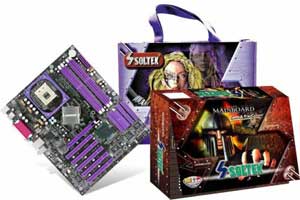
The Soltek SL-PT880Pro-FGR is one of the newest PRO series motherboards introduced by Soltek. To expand the product line, the PRO series have additional features to make them competitive with top-line boards from other manufacturers. There are also value versions of the PT880 available, called the SL-PT880E-R and -RL. The lower cost versions only support 2 DIMMs and do not include the Promise controller.

"Slick" is the only way to describe the new embossed foil, info flap package for the PT880Pro. In the past, Gigabyte has delivered some of the fanciest packaging that we have seen in their 6-Dual series. This Soltek package is in the same league. It is clear that Soltek wants to make the Pro series motherboards stand out from the rest of their line.
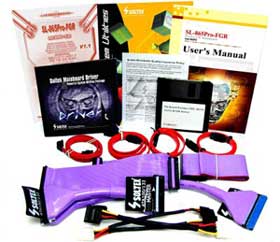
It looks like purple slots go with Pro for Soltek, creating a purple-on-black color scheme. The accessories also include a round purple IDE cable and a purple floppy cable.

The PT880 Northbridge supports up to 4GB of non-ECC Dual-Channel memory. While this chipset can support ECC and up to 8GB of memory, Soltek decided not to implement ECC on the PT880Pro. The feature-rich VT8237 Southbridge has been covered in detail in Athlon 64 reviews. For more detailed information on the 8237, refer to Athlon64 Motherboards: First Look at Chaintech, FIC, and MSI. The 8237 supports 8 USB 2.0 ports, dual ATA133 IDE, Serial ATA with the option for RAID 0 and 1, and provides basic code for a 6-channel audio codec.
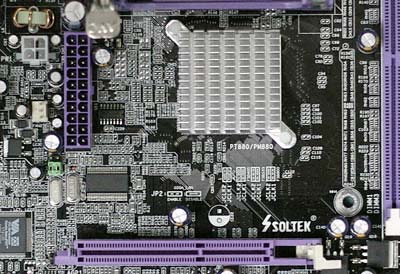
Soltek uses a very tall passive heatsink to cool the Northbridge instead of an active fan as we often see. There are arguments for and against both solutions, but there is a fan connector nearby if you choose to change the Northbridge cooling. We had no problem with overheating of the Northbridge during our testing.

The very full back panel of the Soltek includes 4 USB 2.0 ports, PS2 mouse and keyboard ports, 3 audio mini jacks for 6 speakers or mic and line, 2 serial ports, parallel port, Gigabit LAN, and a Firewire port. While there are headers on the board for 4 additional USB ports, and a second Firewire port, the brackets are an accessory and not included. There is also no header on the motherboard for SPDIF.
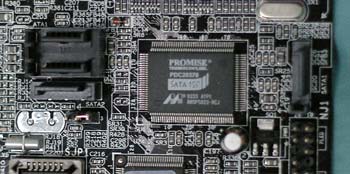
The Soltek PT880Pro provides support for up to 4 SATA drives in standalone or RAID configurations. Two SATA are supported by the 8237 Southbridge and two are supported by the Promise 20378 controller.
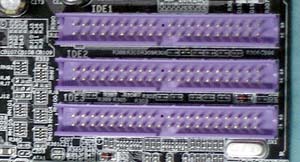
VT8237 supports up to 4 IDE devices and up to ATA133 speed. In addition, 2 more IDE devices are supported by the Promise controller - either as standalone IDE devices or IDE RAID. The Promise 20378 can also control 2 SATA drives plus 2 IDE drives configured as RAID 0+1.

The PT880Pro uses the VIA VT1616 Vinyl Six-Trac audio chip. The 1616 is the 18-bit junior member of the audio family. The top-line Envy24 would have been a better choice for a top-line board, but the 1616 is still very capable, providing 6-channel audio that exceeds Microsoft's WHQL logo requirements for junior member of the VIA Vinyl audio family, ALC658. VIA provides detailed information on the Vinyl Six-Trac capabilities at the VIA web site.
"The VIA Six-TRAC is a complete solution supporting the AC'97 2.2 specification with S/PDIF extension compliance. Enabling 6 channel outputs with 18-bit resolution the VIA VT1616 can support full 5.1 surround sound enabling theatre-quality home audio systems. For optimum playback performance the Six-TRAC analog mixer circuitry integrates stereo enhancement to provide a pleasing 3Ds surround sound effect for stereo media. Further provisions in the hardware allow for downmixing of 6-channel inputs such as DVDs into 4-channel, or even 2-channels outputs.While the chip supports SPDIF, there are no headers on the Soltek PT880Pro to implement this feature. With just 3 audio jacks, you will also be forced to give up Mic and Line capabilities to drive a 6-channel speaker setup.
An 18-bit independent rate stereo ADC enables 5 stereo and 2 mono analog line-level inputs allowing recording from sources such as microphones, CDs, line-ins etc. With sample rate converters on all channels the VIA Six-TRAC can be adjusted in 1Hz increments allowing exacting audio manipulation. To maintain full digital audio paths the VIA VT1616 has an IEC958 line driver for S/PDIF compressed digital or LPCM audio outputs."
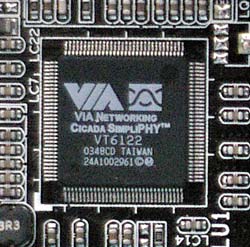
Gigabit LAN is provided by another VIA chip - the VT6122. 10/100/1000Mb data transfer rates are supported.
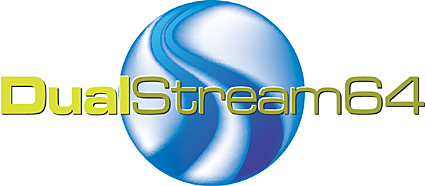
Four DIMM slots support two dual-channel memory banks that can handle unbuffered DIMMs up to DDR400 speed. This is the same configuration provided by Intel's 865/875 chipsets and the SiS655TX. VIA's Dual-Channel design is called DualStream 64, and VIA claims it provides fast, low-latency memory performance on par with Intel chipsets. The PT880 is also the first VIA chipset in recent memory to provide an asynchronous bus design. This means that the PCI/AGP frequency can be fixed at the 33/66 specification while the system and memory clocks are increased to higher levels. This has allowed Intel and SiS chipsets to reach incredible overclocks with the Pentium 4.










5 Comments
View All Comments
snide23 - Wednesday, February 25, 2004 - link
RE: how did it work - so far it is working great, but there appears to be an issue with the Sapphire Radeon 9800 Pro running at AGP 8X setting, though.yak8998 - Monday, February 23, 2004 - link
I skimmed through the article, and was very pleased, especially about the price/features. But then I read about the trashy OC abilities. If they can get this chipset to overclock like an 865/875 board it will be one of the best chipsets to date (and they have to keep the price low)KristopherKubicki - Monday, February 23, 2004 - link
PT880 is kind of an intermediate chipset, i am more interested in pt890.Kristopher
GonzoDaGr8 - Monday, February 23, 2004 - link
Snide, How did that PT880 work out for ya?snide23 - Monday, February 23, 2004 - link
Odd that this is the first board they have seen with the PT880 chipset. NewEgg has been selling the MSI Neo PT880 for a while now. I have already built one system with it.